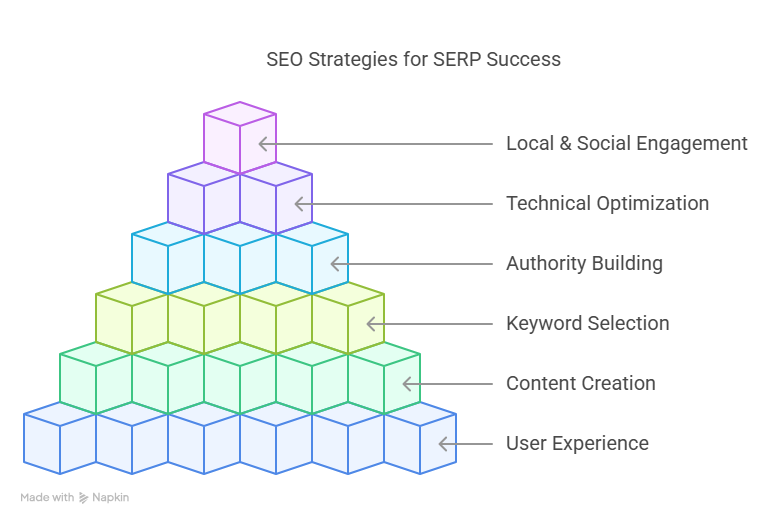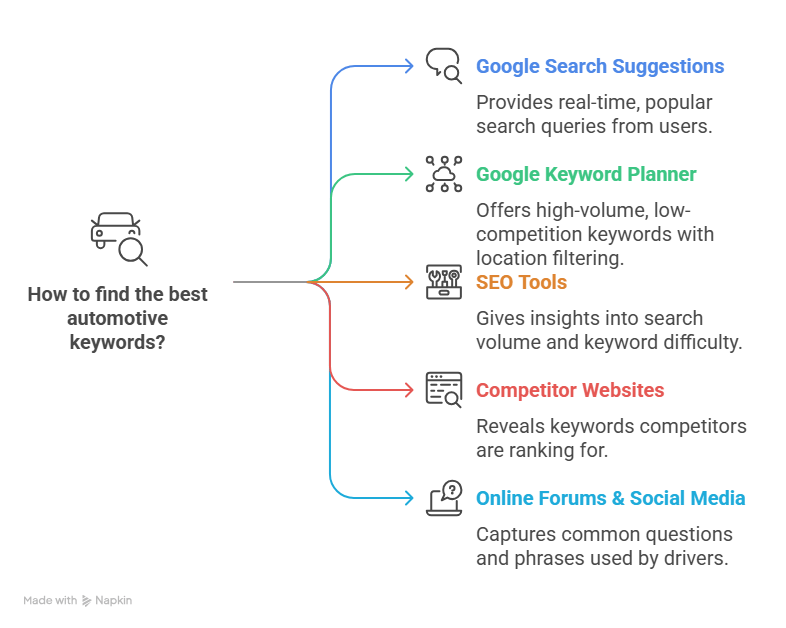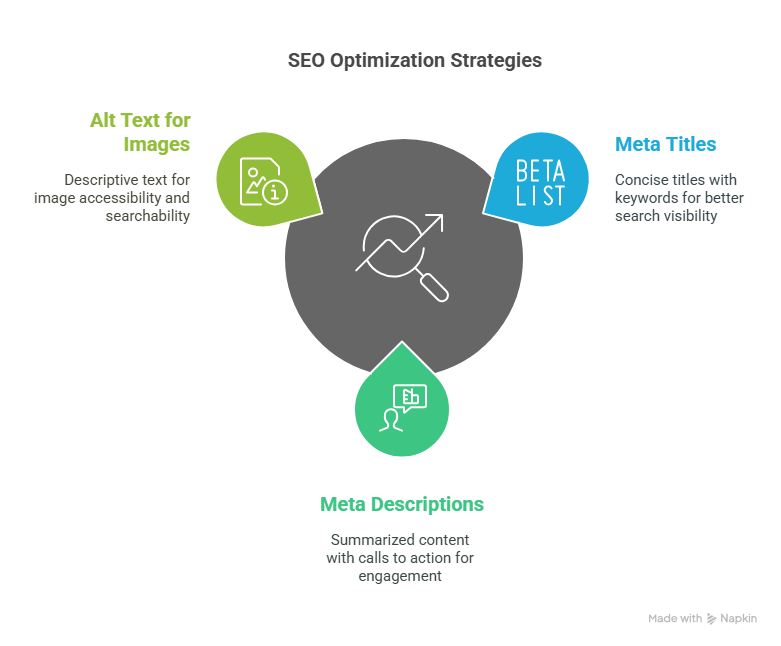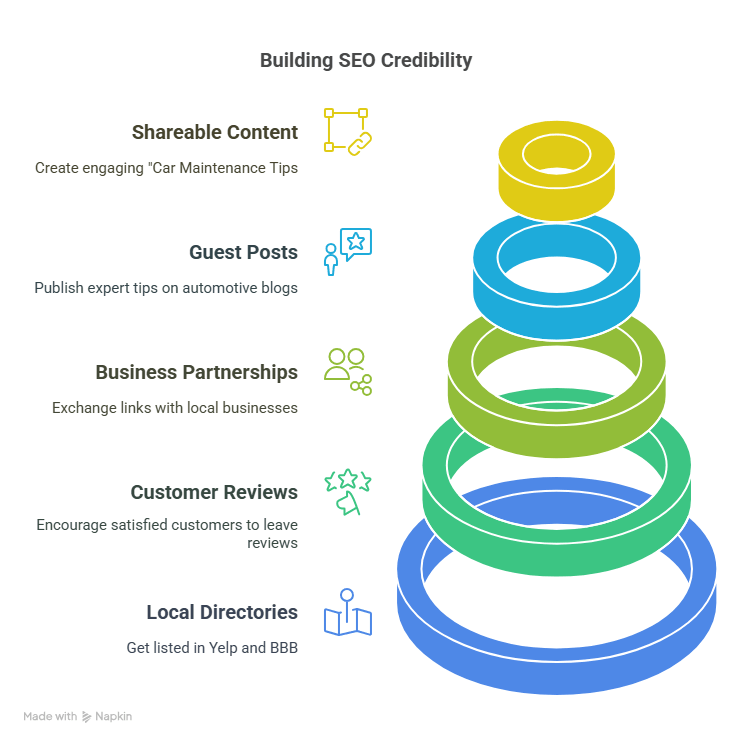Yes! I'd like to be contacted to schedule a consultation!
You’re an automotive specialist with years of experience, the right tools and equipment, responsive service, and competitive prices. So why isn’t your phone ringing off the hook? In the past, word of mouth and a phonebook listing were enough of a marketing effort to keep your schedule full.
Now, drivers are using search engines like Google to find answers to their questions about car problems, service pricing, and where to find the best local mechanic. According to Google, over 25% of all automotive searches are related to parts, service, and maintenance. You can’t afford to lose out on these and other avenues to capture market growth. If you’re not using search engine optimization (SEO) to fine-tune your site’s performance, you’re no longer in the race.
Don’t let your competitors leave you in the dust. In this guide, LinkNow’s SEO specialists show you how to give your website and content a performance overhaul that puts your business front and center when people search for a mechanic online.
Mechanics need to know about SEO because it’s a critical tool for attracting more customers to your auto repair business. If your website isn’t optimized for search engines, potential clients searching for local mechanics, brake repairs, or oil changes may never even know you exist.
Think about how drivers search for car services today.
Instead of flipping through a phonebook, they pull out their smartphones and say or type searches like:
When your website isn’t appearing in the top search results, you’re missing out on a huge customer base. SEO gives your site the turbo charge it needs to rank higher, making it easier for potential clients to find you instead of your competitors.
Yes, you can use SEO best practices to rank high and rank locally. Keep reading for step-by-step instructions on how to dominate search results in your region.
When someone searches for a mechanic, Google works behind the scenes to find the best match. It looks at how well your website answers their question, whether you have helpful content, and if other trusted sites link to yours. Reviews, location details, and how easy your site is to use also play a big role.
If your pages are clear, mobile-friendly, and packed with helpful information about your services, Google is more likely to show them at the top. The better your online presence, the easier it is for customers to find you and book an appointment when they need car repairs.
Here’s an overview of the steps you can take to help your car service site rise to the top of search engine results pages (SERPs):

User experience (UX) is how visitors interact with your website, including how easy it is to navigate, how fast it loads, and how well it works on mobile devices. A smooth, frustration-free experience engages potential customers and encourages them to book your services. Google prioritizes websites that offer great UX, meaning if your site is slow, cluttered, or hard to use, it can hurt your rankings.
A well-designed site with clear service pages, easy appointment booking, and helpful content keeps visitors on your page longer. It shows Google and potential clients that your shop is a trusted, go-to option over your competitors.
It’s not just enough to fill a page with words and graphics. Drivers who visit your site want the real meat and potatoes.
Here’s how to write content that helps you make a strong connection and build trust with your target audience:
Drivers turn to Google when they experience car trouble. Each page on your site should answer drivers’ questions related to your auto services. For example, people want to know things like, “How often should I change my oil?” “What are the signs I need new tires?” and “How long does it take to replace my muffler?”.
They also want to know if you offer mobile mechanic services and can provide roadside or onsite assistance, how much your services cost, what your business hours are, and how to get in touch with you to book an appointment. When you make it easy for searchers (and search engines) to find this information, they see you as a trusted resource that deserves their business and a top spot in search results.
Your keywords act as bridges connecting your business to the right audience. To drive results, you need to include relevant, intent-driven keywords that match what potential customers are actually searching for.
These tips will help you strategically select automotive keywords for your content:
Choosing the right automotive keywords is essential for ranking well in search results and attracting the right customers to your shop.
But where do you find them?
Try typing basic searches like “brake repair near me” or “how much does an oil change cost?” into Google. Look at the autocomplete suggestions and the “People Also Ask” section. These are real search queries from drivers looking for auto services.
This free tool from Google Ads helps you discover high-volume, low-competition keywords for your auto repair business. You can filter by location to find what drivers in your area are searching for most.
These advanced tools provide deeper insights into search volume, keyword difficulty, and related search terms to help you choose the best automotive keywords.
Check what keywords your competitors are ranking for by analyzing their meta titles, headers, and blog topics. Tools like Ahrefs’ Site Explorer or SEMrush’s Keyword Gap can help you identify ranking opportunities.
Drivers often ask car-related questions in places like Reddit’s r/MechanicAdvice, Quora, and Facebook groups. Pay attention to the exact wording of their questions, and use those phrases in your content.

Blogging holds more engagement power than you may initially think. While many mechanics focus solely on service pages, adding a blog allows you to answer common customer questions, demonstrate your expertise, and provide valuable content that converts visitors into customers and keeps them coming back to your site when they need auto services.
The best mechanic blogs address users’ search intent (why they’re looking for auto service in the first place) and give them information they can use to move further along their buyer journey. Blogs are often best suited to providing thorough answers to long-tail or question keywords.
If you’re unsure where to start, consider writing about:
Check out our post about how to write an SEO-friendly blog post for step-by-step instructions on how to set your automotive service business up for blogging success.
For auto repair professionals, the ideal blogging frequency depends on your goals, resources, and audience demand. Aim for consistency. Whether you weekly or monthly, maintaining a regular schedule helps build trust with readers and keeps your website active in Google’s eyes.
Publish your blogs early in the week (Monday to Wednesday), in the morning or early afternoon (9 AM to 2 PM) when readers are most likely to research car issues and book services. No matter your schedule, quality matters more than quantity. A well-researched, engaging blog post once a month is better than multiple rushed, low-quality posts.
Metadata helps search engines understand what your web pages are about. Every page on your site should have optimized meta titles and descriptions that include relevant keywords and clearly explain what the page offers.
Here are some tips:

Internal links are clickable (anchor) text that guides users from one page on your website to another. You may have noticed the two examples we slid into the section above. They help visitors navigate your site easily, keep them engaged longer, and show search engines how your content is connected.
For example, if you’re writing about brake repair services, you can link to:
Using strategic internal links improves SEO, boosts page authority, and ensures visitors find relevant information—ultimately increasing their chances of trusting you to fix their vehicle over your competitors.
Internal links help users get around your site and access all the auto service information they’re looking for. However, you’ll still need to turn your attention to another type of link that’s a heavy hitter for establishing your credibility within your community and online. Backlinks are links from other reputable websites that take people over to yours. Google sees links back to your site as a vote of confidence that shows your site is a trusted source of information about auto service, installations, upgrades, and repairs.
To earn high-quality backlinks, you should:

Local SEO helps you reach potential clients who live, work, visit, and do business in your area. They’re folks who’ve run into engine trouble, a soft brake pedal, a suspicious noise, or a check engine light, and they need a certified technician to fix their car.
You want your content to be the first thing that pops up when they’re searching for automotive solutions. How do you use local SEO to do it?
Local SEO best practices include:
To be included in the Google Maps Pack, you’ll need to meet the search giant’s requirements. Google wants to serve searchers with relevant pages that match their search intent and offer trustworthy and nearby solutions. We’ve written detailed instructions on how to add your car repair business to Google Maps over on our blog.
Social media is a tool that helps you build relationships, increase awareness about your auto service company, and book more appointments for auto diagnostic, repair, and maintenance services. Creating engaging, informative, and interactive content connects you with potential customers where they spend their time online—on platforms like Facebook, Instagram, LinkedIn, and TikTok.
On social media, you can show potential clients what makes you relatable, trustworthy, and the right choice for the job by:
Auto specialists can maximize reach and build a loyal customer base by using video content, going live with question-and-answer sessions, encouraging user-generated content, running promotions and giveaways, and using local hashtags and geotags.
When you put time into establishing a strong social media presence, potential clients feel like they know you and that you’re making an effort to understand and engage with them.
To know when your SEO is working, you’ll need to know what’s driving traffic to your site, generating leads, and converting visitors into customers.
Here’s how you can measure whether your SEO efforts are paying off (and identify areas for improvement):
SEO isn’t rocket science, but just like fixing cars, there are many moving parts, and few people have the time, patience, tools, knowledge, and experience to do it themselves, especially when they have a business to run.
Do you need an SEO specialist to help you tune up your web presence so you can get more service appointments on the books? Book a free consultation with LinkNow’s search engine optimization and content marketing experts, and let us help you take your automotive service shop to the top of search engine results.